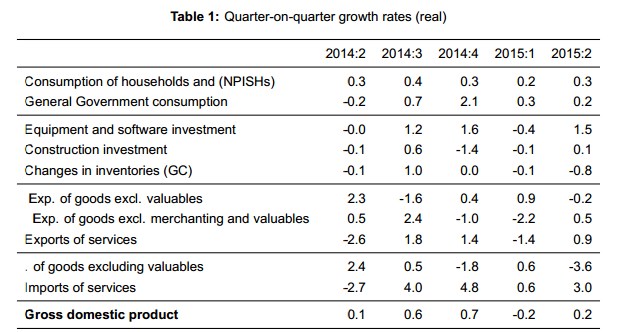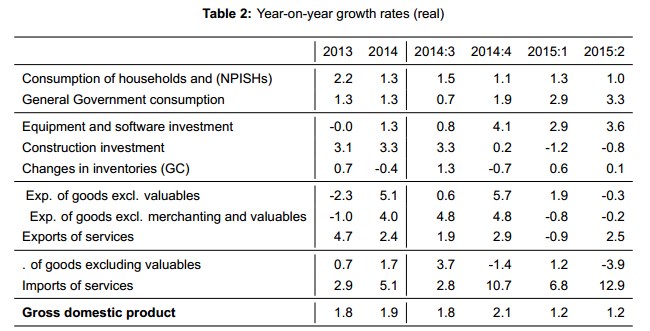Swiss GDP increased by 0.2% q/q and 1.2% y/y. Once again, investments on equipment and software (+3.6%) was one of the main drivers. For many economists investment on equipment and software is the most desired GDP growth component.
SECO: Gross domestic product in 2nd quarter 2015
(source)
Each quarter, the Swiss department of economics (SECO) estimates the GDP and its components. The main purpose of these estimations is to provide data that allows for an assessment of the cyclical development of the main macroeconomic aggregates in a timely adequate and credible manner.Switzerland’s real gross domestic product (GDP) grew by 0.2% in the 2nd quarter of 2015 compared to the previous quarter. The balance of trade in goods made a positive contribution to GDP growth because imports fell more than exports; on the other hand, the balance of trade in services had a negative impact. Consumption expenditure by private households and government together with investments also provided support for GDP growth in the 2nd quarter of 2015. Compared to the 2nd quarter of 2014, GDP grew by 1.2%; the GDP deflator decreased in the same period by 1.1%.
Graph:
real GDP – percentage change to previous quarter and volume index: 2010:1-2015:2, volume index (2010=100), at prices of the preceding year, chained values, reference year 2010, seasonally and calendar adjusted data
Detailed Data
(source)
Quarterly Change of GDP
Imports of goods fell by 3.6% QoQ, while exports of goods remained nearly stable. This lead to another increase of the trade balance for goods.
But the trade balance for services was weakened by imports of services (e.g. Swiss traveling abroad or foreign residents delivering services in Switzerland).
Despite strong immigration, consumption growth remained at relatively weak levels also seen in 2014. The
Yearly Change of GDP
The yearly figures express similar tendencies:
- Weak household consumption growth and relatively strong growth of government consumption.
- Growth of investments on equipment and software, as opposed to 2013 and 2014 (change of methodology for intellectual property)
- The construction got hit by negative rates that the banks carried forward to the sector and by an expected slowdown of immigration
- Heavy growth on imports of services countered the rising trade surplus on goods.
















